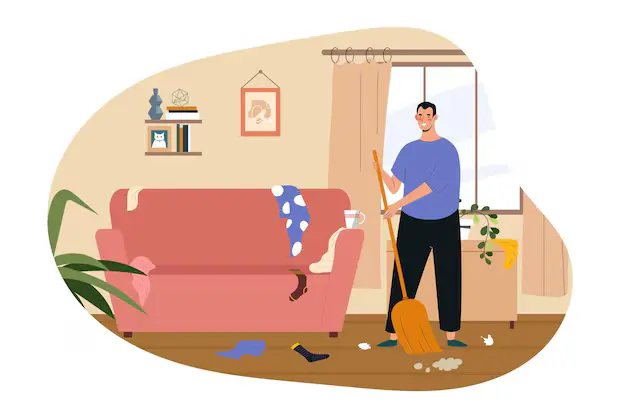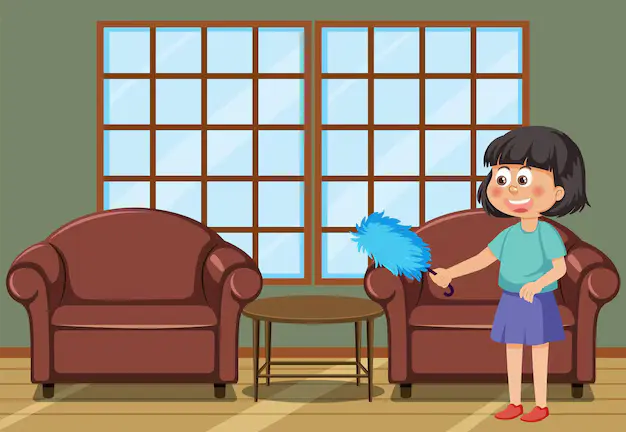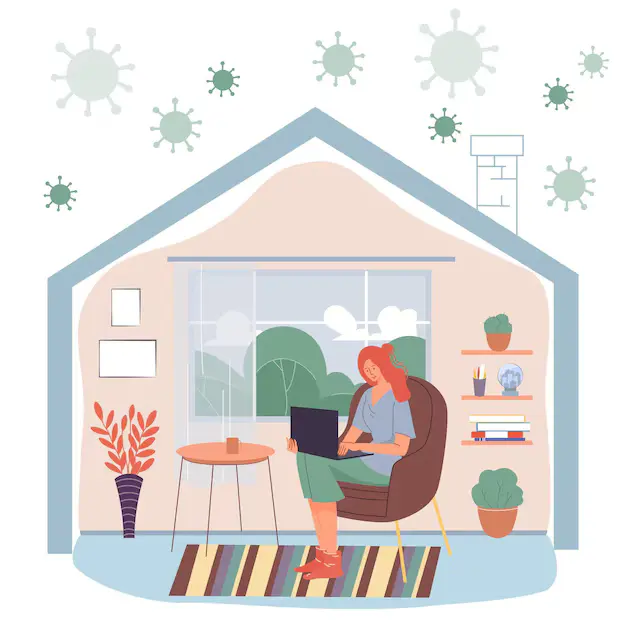Introduction
As a cleaning expert, we know how difficult is to handle the dust. You can see it on your shelves, furniture, across the floors, and dust is present even in the air you breathe. It may feels like a never-ending battle because no matter how much you clean, dust always comes back. What makes the situation worse is that dust can arouse allergies, trigger sneezing in many people that makes your home a hard place to live in.
There are numerous of reasons for why your home is so dusty. Firstly, if you’re opening windows of your home, this can bring the outdoor dirt in. You can fix this by keeping them closed on windy days. Secondly, while cleaning we almost neglect high touch areas like ceiling fans, but this is the most dirtiest zone of your house and can spread dust into your rooms. You should clean them in a week for heathy living. And if you have carpets or rugs, they trap dust particles easily, you should vacuum with a HEPA filter and clean your carpets monthly or weekly to keep the dust under control. Taking these steps not only reduces dust but creates a healthier, more comfortable home for you and your family.
In this guide, we’ve elaborated the top 10 reasons of why your home may be dustier and, most importantly, share best solutions to fix it. Dust is a universal problem for homeowners across Canada, including Coquitlam residents. But by following the right habits and having a better understanding of where dust comes from, you can create a fresher, healthier home environment.
We understand that not everyone can manage dust on their own, which is why we offer maid services in Coquitlam to help you in keeping your home not just clean, but also truly fresh and healthy.
Dust and Allergies: Why It Matters for Your Health

If you’ve ever woken up with a stuffy nose, itchy eyes, or constant sneezing, your home’s dust may be the reason. Dust mites are one of the most common allergy triggers found in Canadian households. These dust particles thrive in warm, humid spots like bedding, carpets, and upholstered furniture.
For allergy sufferers, even small amounts of dust can:
- Trigger sneezing, coughing, and watery eyes
- Worsen asthma symptoms by irritating the lungs
- Disturb your sleep and leave you feeling less rested
- Increase fatigue and headaches due to poor indoor air quality
Removing dust isn’t just about keeping your home looking clean, it’s about making your home a healthier place to live. Studies show that reducing dust exposure can improve sleep quality, ease allergy symptoms, and lower the risk of respiratory problems.
If anyone in the family struggle with allergies, focus on regular dust control in bedrooms first, since that’s where you spend nearly most of your time.
Mesh Maids Tip: Use our ultimate bedroom cleaning checklist for dust control in bedroom and enjoy dust-free home.
10 Reasons Why Your Home Is So Dusty and How to Fix it
Dust never seems to take a day off. You wipe, sweep, or vacuum, and within hours it’s back on your shelves, floors, and furniture. Beyond just looking messy, dust can irritate allergies, affect air quality, and even make your home feel less comfortable.
We are describing the top 10 reasons of why your home is dusty and what you can do to fix it.
1. Poor Air Filtration
Why It Matters
Your HVAC system plays a big role in controlling dust. If your air filters are clogged or low-quality, dust will circulate freely instead of being trapped.
How to Fix It
- Replace HVAC filters every 1–3 months.
- Use HEPA filters for the best results.
- Consider duct cleaning to remove dust buildup inside vents.
2. Carpets and Rugs Trap Dust
Why It Matters
Carpets act like magnets for dust, trapping dirt deep in their fibers. Every step you take releases dust back into the air.
How to Fix It
- Vacuum at least twice a week with a vacuum that has a HEPA filter.
- Deep clean carpets every 6–12 months.
- If possible, clean carpet with vinegar and baking soda, which helps in keeping carpet dust-free.
3. Dusty Upholstery and Curtains

Why It Matters
Fabric furniture, curtains, and cushions collect dust quickly, especially if they’re not cleaned regularly.
How to Fix It
- Wash curtains every 3–6 months.
- Vacuum upholstered furniture weekly.
- Use washable slipcovers for easier maintenance.
4. Clutter Collects Dust
Why It Matters
More items mean more surfaces for dust to settle on. Decorative pieces, books, and knick-knacks are dust’s favorite resting spots.
How to Fix It
- Declutter your home regularly.
- Store items in closed cabinets instead of open shelves.
- Adopt a “less is more” approach.
5. Leaky Windows and Doors
Why It Matters
Dust doesn’t just appear inside, it enters from outside. Open windows and doors are open invitations for dirt, pollen, and other particles.
How to Fix It
- Seal gaps with weather-stripping or caulk.
- Install air-purifying plants near entry points.
- Keep doormats inside and outside entrances to reduce tracked-in dust.
6. Pets and Pet Dander
Why It Matters
Your pets are adorable, but they shed hair and dander that quickly turn into dust.
How to Fix It
- Brush pets regularly to reduce shedding.
- Wash pet bedding weekly.
- Vacuum floors and furniture daily if you have heavy shedders.
7. Dirty Air Ducts and Vents
Why It Matters
When dust collects in air ducts, it gets blown back into your living spaces every time the system runs.
How to Fix It
- Inspect ducts annually.
- Hire professionals for a duct cleaning service when necessary.
- Keep vents clean by vacuuming them monthly.
8. Rarely Washed Bedding
Why It Matters
Beds are one of the dustiest places in the home. Skin flakes, hair, and fabric fibers collect daily.
How to Fix It
- Wash sheets weekly in hot water.
- Vacuum your mattress monthly.
- Use dust-mite-proof covers for mattresses and pillows.
9. Neglected Ceiling Fans and Light Fixtures
Why It Matters
Ceiling fans and fixtures gather dust fast—and every time you turn them on, they scatter particles across the room.
How to Fix It
- Wipe ceiling fans every 2 weeks with a microfiber cloth.
- Use extendable dusters for light fixtures.
- Clean before turning on the fan, especially after long periods of disuse.
10. Infrequent Cleaning Habits
Why It Matters
Even small cleaning delays can give dust more time to settle and spread.
How to Fix It
- Establish a weekly cleaning schedule.
- Focus on high-dust zones like baseboards, shelves, and window sills.
- Use microfiber cloths, which trap dust better than feather dusters.
Keeping dust under control is all about understanding where it comes from. With over years of experience, we believe how small changes like upgrading filters, washing fabrics regularly, or sealing windows can make a big difference in keeping homes fresher and healthier. By staying consistent with these habits, you’ll improve the air you breathe, creating a cleaner and more comfortable home for your family.
Dust Hotspots You Probably Forget
Even if you’re great at keeping up with cleaning, there are sneaky spots in every home where dust builds up fast and contributes in making your home looks more dusty. Most of us don’t notice until it’s out of control. These hidden areas not only collect dust but also release it back into the air, making your home feel less fresh than it really is.
1. Baseboards
They’re often ignored during house cleaning but baseboards act like dust ledges. Over time, they collect a surprising amount of dirt, pet hair, and debris.
Fix It: Wipe them down every couple of weeks with a damp microfiber cloth or use a vacuum attachment for quick touch-ups.
2. Behind the Fridge & Under Appliances
Out of sight, out of mind — but these spots are dust magnets. When dust mixes with grease in the kitchen, it creates a sticky mess that’s harder to clean and can even affect your fridge’s efficiency.
Fix It: Pull out the fridge (or at least use a long-handled duster) every few months. Do the same under the stove and laundry machines.
3. Ceiling Corners
Ever notice cobwebs appearing even if you don’t see spiders? That’s dust binding together in ceiling corners. It’s one of the first places guests notice if you miss it.
Fix It: Use an extendable microfiber duster to sweep corners once a month — no ladder needed.
4. Under Large Furniture (Sofas & Beds)
If you’ve ever moved your polyester couch or bed. You will always find “dust bunnies” underneath. These hidden piles circulate dust every time you walk by.
Fix It: Vacuum or sweep under big furniture every few weeks, especially if you have pets. For low-clearance furniture, a slim dusting tool works wonders.
Dust doesn’t just sit still, it moves around with air flow. Tackling these forgotten spots makes your whole home feel cleaner, fresher, and gives you a roadmap of making your home less dusty.
Seasonal Factors That Increase Dust
Living in Canada means your home faces big seasonal shifts, and with those changes come new sources of dust. From snowy winters to pollen-heavy springs, each season adds its own layer of particles that settle inside your home. Seasonal factors play a vital role in making your home so dusty. Here’ how:
Spring: Pollen Season
When spring arrives, trees, grasses, and flowers release pollen and much of it makes its way indoors. Even if you keep windows closed, pollen can stick to clothing, shoes, and pets. This extra layer mixes with regular household dust, often triggering sneezing, watery eyes, or allergy flare-ups.
How to Fix It:
- Remove shoes at the door to reduce tracked-in pollen.
- Wipe down pets’ paws and fur before they come inside.
- Vacuum floors and upholstery more frequently during peak months.
Winter: Dry Air and Heating Systems
In winter, furnaces and heating systems run constantly. While they keep us warm, they also stir up dust from vents and circulate it through the home. On top of that, Canada’s cold, dry winter air makes dust particles lighter and easier to spread. This is why many people notice their homes feel dustier in January and February.
How to Fix It:
- Replace furnace filters every 1–3 months.
- Use a humidifier to maintain indoor humidity at 40–50% (helps dust settle instead of floating).
- Book professional duct cleaning every few years to remove built-up dust and debris.
Summer and Fall: Open Windows & Shedding Season
Summer breezes are refreshing, but open windows also invite outdoor dust, pollen, and pollution inside. Fall adds another challenge: many pets shed heavily as they grow thicker coats for winter, contributing extra dander and hair.
How to Fix It:
- Use window screens to reduce outdoor particles.
- Brush pets regularly to minimize shedding.
- Schedule a deep clean in late fall to reset your home before winter sets in.
By understanding these seasonal factors, you can stay one step ahead of dust. Adjusting your cleaning routine with the seasons not only keeps your home looking spotless but also helps you breathe easier year-round.
Pro-Tip: Book our spring cleaning services for best results.
The Role of Humidity in Dust Control
If you live in Canada, you know how extreme the seasons can be. Winters bring dry indoor air from constant heating, while summers sometimes feel humid and sticky. Both of these affect the amount of dust in your home and makes your home look dusty.
- When the air is too dry : Dust clings to surfaces more easily because static electricity builds up. You may notice dust piling up faster on your LCD TV screen, shelves, and electronics.
- When the air is too humid : Extra moisture encourages mold and mildew, which combine with dust and make the air feel heavier and less healthy.
What You Can Do: Keep your indoor humidity between 40–50%. A humidifier can help in the winter, while a dehumidifier or better ventilation helps in the summer. Not only will this reduce dust, but it will also make your home more comfortable to breathe in.
If you’re sneezing more often during winter or noticing musty smells in summer, it’s a sign your home’s humidity may be out of balance — and that’s when dust becomes more stubborn.
How Mesh Maids Can Help You Clear Dust
At Mesh Maids, we understand that life is busy. Dust builds up quickly, and sometimes you simply don’t have the time or energy to stay ahead of it. That’s where we come in with:
- Deep cleaning services that tackle hidden dust in carpets, vents, and upholstery.
- Regular house cleaning to keep your home fresh and breathable.
- Move-out cleaning so you can start fresh without lingering dust.
When you choose Mesh Maids, you’re not just hiring a cleaning service, you’re investing in a healthier home and cleaner air for your family. Contact us and let us help you, to get relief from your dusting problems.
Conclusion
Dust is inevitable, but it doesn’t have to control your home. By understanding the 10 reasons why your home is so dusty and following these practical solutions, you can dramatically reduce dust and breathe easier.
Whether it’s poor air filtration, pet dander, or clutter, each factor has a fix and with consistent habits and a little help from Mesh Maids, your home can be fresher, cleaner, and more comfortable.
So the next time you notice dust piling up, schedule your cleaning with Mesh Maids and let us make a dust-free home for you.
